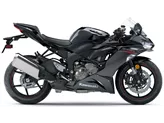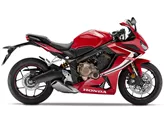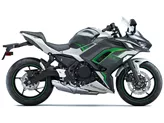Kawasaki Ninja 650 2017 vs. Kawasaki Ninja ZX-6R 2019

Kawasaki Ninja 650 2017

Kawasaki Ninja ZX-6R 2019
Overview - Kawasaki Ninja 650 2017 vs Kawasaki Ninja ZX-6R 2019
The Kawasaki Ninja 650 model year 2017 and the Kawasaki Ninja ZX-6R model year 2019 are both supersport motorcycles with their own unique features and specifications.
Starting with the Kawasaki Ninja 650 2017, it is equipped with an inline engine with a displacement of 649cc. It has a power output of 68.2 HP and a torque of 65.7 Nm. The engine features a DOHC valve system with 4 valves per cylinder. The compression ratio is 10.8, providing good power and performance. The throttle bore is 36mm, allowing for smooth and responsive acceleration. The bike has a steel frame and a telescopic fork front suspension with a diameter of 41mm. The rear suspension is a swing arm with a monoshock absorber and preload adjustment. The braking system consists of double disk brakes with a diameter of 300mm and ABS technology. The bike has a wheelbase of 1410mm and a seat height of 790mm. The fuel tank capacity is 15 liters.

Kawasaki Ninja 650 2017
On the other hand, the Kawasaki Ninja ZX-6R 2019 is equipped with an inline engine with a displacement of 636cc. It has a power output of 130 HP and a torque of 70.8 Nm. The engine features a DOHC valve system with 4 valves per cylinder. The compression ratio is 12.9, providing high performance and power. The throttle bore is 38mm, allowing for quick and responsive acceleration. The bike has an aluminum frame with a twin tube, perimeter, extruded frame type. The front suspension is an upside-down telescopic fork with a diameter of 41mm. The rear suspension is a swing arm with a monoshock absorber and compression, preload, and rebound adjustment. The braking system consists of double disk brakes with a diameter of 310mm and radial technology. The bike has a wheelbase of 1400mm and a seat height of 830mm. The fuel tank capacity is 17 liters.
In terms of strengths, the Kawasaki Ninja 650 2017 has a transparent chassis for a sporty look and good handling. It also has excellent brakes and a resilient engine. On the other hand, the Kawasaki Ninja ZX-6R 2019 has a great engine with a good mix of revving and torque. It offers lively handling and a well-responsive fork. The chassis is adjustable and provides a decent riding experience.

Kawasaki Ninja ZX-6R 2019
However, both models have their weaknesses. The Kawasaki Ninja 650 2017 has little sound from the stock exhaust and the engine shows slight vibrations. The Kawasaki Ninja ZX-6R 2019 has some details that could be improved, such as the number plate holder and indicators. Additionally, some riders feel that the overall silhouette of the bike is not sporty enough and lacks aggressiveness.
In conclusion, both the Kawasaki Ninja 650 2017 and the Kawasaki Ninja ZX-6R 2019 offer their own unique features and strengths. The Ninja 650 is known for its playful handling and resilient engine, while the Ninja ZX-6R offers a great engine and lively handling. However, both models have their weaknesses that may affect the overall riding experience.
Technical Specifications Kawasaki Ninja 650 2017 compared to Kawasaki Ninja ZX-6R 2019
Pros and Cons in comparison
Pros and Cons in comparison
Kawasaki Ninja 650 2017

The Ninja 650 firmly stamps its predecessor (Er-6f). The engine has mastered the Euro 4 hurdle well and serves up a very usable 68 hp, the chassis is simply great for this class, and the weight reduction of 18(!) kilos compared to the ER-6f justifies reverent nods.
Kawasaki Ninja ZX-6R 2019

The Kawasaki Ninja ZX-6R is a perfectly sized supersport motorbike. With its 130 hp, sporty but controlled riding is possible. The shorter gearing and the 36cc extra displacement ensure that you can be a bit lazier on the road. A worthy flag-waver for the 600cc supersport segment.
Price Comparison Avarage Market Price Kawasaki Ninja 650 vs Kawasaki Ninja ZX-6R
There are a few key differences between a Kawasaki Ninja 650 2017 and a Kawasaki Ninja ZX-6R 2019. In terms of price, the actual average price of a Kawasaki Ninja ZX-6R 2019 is about 134% higher. Compared to Kawasaki Ninja ZX-6R 2019 there are more Kawasaki Ninja 650 2017 bikes available on the 1000PS.de Marketplace, specifically 7 compared to 4. It takes less time to sell a Kawasaki Ninja 650 with 96 days compared to 160 days for a Kawasaki Ninja ZX-6R. Since model year 2017 1000PS.de editors have written 20 reviews for the Kawasaki Ninja 650 and 37 reviews for the Kawasaki Ninja ZX-6R since model year 2005. The first review for the Kawasaki Ninja 650 was published on 10/4/2016 and now has more than 79,600 views. This compares to more than 5,800 views for the first review on Kawasaki Ninja ZX-6R published on 9/2/2002.





























